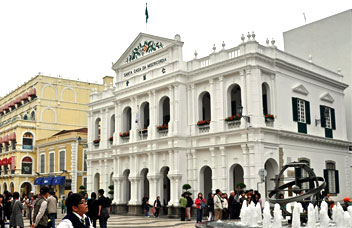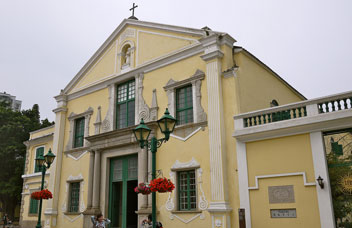- Tour Packages
- Discover Macau
- Tourist Attractions
- Heritage Sites
- A-Ma Temple
- Macau Wine Museum
- Grand Prix Museum
- Moorish Barracks
- Lilau Square
- Mandarin's House
- St. Augustine's Square
- Dom Pedro V Theatre
- Sir Robert Ho Tung Library
- Leal Senado' Building
- Senado Square
- Sam Kai Vui Kun (Kuan Tai Temple)
- Lou Kau Mansion
- Na Tcha Temple
- Section of the Old City Walls
- Mount Fortress
- Casa Garden
- Churches in Macau
- Ruins of St. Paul's
- Hotels
Churches
When the Portuguese arrived in Macao more than four and a half centuries ago, they brought Catholicism with them and built many churches and convents. The old College of St. Paul served as the first Western university in Asia and became a significant entry point to China for foreign missionaries. Today, Macao is divided into Catholic dioceses on map, and magnificent Catholic churches can be found everywhere. Visit uniquely designed churches and learn more about their fascinating history.

St. Lawrence's Church
Built by the Jesuits in the mid-16th century, this is one of the three oldest churches in Macao. Its present appearance and scale was acquired in 1846. Situated on the southern coastline of Macao overlooking the sea, families of Portuguese sailors used to gather on the front steps of the church to pray and wait for their return, hence it was given the name: Feng Shun Tang (Hall of the Soothing Winds). The neighborhood where the church is located used to be fairly wealthy, thus explaining the building's scale and wealth of architectural treatment. It is a neo-classical structure, with subtle Baroque decorative inspirations.
St. Augustine's Church
First established by Spanish Augustinians in 1591, this church maintains the tradition of organizing one of the most popular processions through the city, the Easter Procession, involving thousands of devotees. In times past, during heavy rain, the priests used to reinforce the rooftop with fan palm leaves. Seen from afar, these leaves appeared to be dragon's whiskers floating in the wind, hence the local Chinese named it Long Song Miu (Temple of the Long-whiskered Dragon).

Holy House of Mercy
The Holy House of Mercy of Macau (Portuguese: Santa Casa da Misericórdia; is a historic white building in Senado Square, Macau, China. Established as a branch of the Santa Casa da Misericórdia, it was built in 1569 on the orders of the Bishop of Macao. It was a medical clinic and several other social welfare structures in early Macau. It later served as an orphanage and refuge for widows of sailors lost at sea. It is part of the UNESCO World Heritage Site "Historic Centre of Macau".
Cathedral
Built around 1622, the Cathedral was originally constructed with taipa (compound material consisting soil and straw). During the restoration of 1780, the religious services of the Cathedral were temporarily transferred to the old chapel of the Holy House of Mercy. The facade is characterized by pilasters and the twin belfries that stand out on the streetscape. The exterior is clad in Shanghai plaster, giving the church a monolithic subdued appearance.

St. Dominic's Church
Founded in 1587 by three Spanish Dominican priests who originally came from Acapulco in Mexico, this church is also connected to the Brotherhood of Our Lady of the Rosary. It was here that the first Portuguese newspaper was published on Chinese soil, A Abelha da China ("The China Bee"), on 12th September 1822. The bell tower, at the back of the building, has been modified into a small Museum of Sacred Art, now exhibiting a collection of around 300 artifacts.
Ruins of St. Paul's
The Ruins of St. Paul's refer to the facade of what was originally the Church of Mater Dei built in 1602-1640, destroyed by fire in 1835, and the ruins of St. Paul's College, which stood adjacent to the Church. As a whole, the old Church of Mater Dei, St. Paul's College and Mount Fortress were all Jesuit constructions and formed what can be perceived as the Macao's "acropolis". Close by, the archaeological remains of the old College of St. Paul stand witness to what was the first western-style university in the Far East, with an elaborate academic program. Nowadays, the facade of the Ruins of St. Paul's functions symbolically as an altar to the city.

St. Anthony's Church
First built of bamboo and wood before 1560, this is one of the oldest churches in Macao, also marking the site where the Jesuits set up their earliest headquarters in the city. The church was reconstructed in stone several times, while the present appearance and scale of the church dates back to 1930. Previously, members of the Portuguese community would hold wedding ceremonies there, so giving rise to the Chinese name of Fa Vong Tong (Church of Flowers).
Guia Chapel
This chapel was first built in the 17th century as part of the Guia Fortress. The present chapel dates from 1637, containing the image of the Virgin and a fine old painting of St. John the Baptist. During the restoration of the chapel in 1996, the oldest vestige of paintings that dates back to the construction of the hermitage in 1622 were founded. The murals are characterized by Oriental and Occidentals symbols.
St. Joseph's Seminary and Church
Established in 1728, the old Seminary, together with St. Paul's College, was the principal base for the missionary work implemented in China, Japan and around the region. St. Joseph's Seminary taught an academic curriculum equivalent to that of a university and in 1800 the Portuguese Queen Dona Maria I conferred on it the royal title of "House of the Mission Congregation". Adjacent to the Seminary is St. Joseph's Church, built in 1758, an exemplary model of baroque architecture in China, as noted in UNESCO's 2001 publication Atlas mundial de la arquitectura barroca.

Protestant Chapel
To serve Macao's small Protestant minority this chapel is appropriately situated in the cemetery where 150 British and American graves recall the days of the foreign trading and naval presence in Macao. The small stone building is sometimes called the "Morrison Chapel" in honor of Robert Morrison, a missionary who translated the Bible into Chinese, and the stained glass window contains the art picture of an open Bible with Chinese characters for "In the beginning was the Word". On either side of the altar are plaques recalling James B. Endicott, an American trader who is buried in Hong Kong, and Henry Davies Margesson who drowned off Yokohama when returning home to England after 23 years in China.
